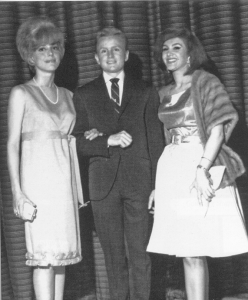TG History — Pay It Forward, Reed Erickson
 “Make the world a bit better or more beautiful because you have lived in it.”– Edward Bok
“Make the world a bit better or more beautiful because you have lived in it.”– Edward Bok
Who was the most influential transgendered person in history? Now there’s a question that’s certainly subject to lively debate. But a strong case could be made for a man you most likely never even heard of. His name was Reed Erickson.
 Erickson was born Rita Alma Erickson on October 13, 1917 in El Paso, Texas. The product of a wealthy family Erickson’s early years were spent in Philadelphia, where he graduated from the Philadelphia High School for Girls and later attending Temple University. The Ericksons then moved to Baton Rouge the site of the family business. While there Erickson attended Louisiana State University, becoming the first woman to graduate from the LSU School of Mechanical Engineering. Erickson briefly returned to Philadelphia to work as an engineer before returning to Baton Rouge, first working for the family company and later starting an independent company making stadium bleachers.
Erickson was born Rita Alma Erickson on October 13, 1917 in El Paso, Texas. The product of a wealthy family Erickson’s early years were spent in Philadelphia, where he graduated from the Philadelphia High School for Girls and later attending Temple University. The Ericksons then moved to Baton Rouge the site of the family business. While there Erickson attended Louisiana State University, becoming the first woman to graduate from the LSU School of Mechanical Engineering. Erickson briefly returned to Philadelphia to work as an engineer before returning to Baton Rouge, first working for the family company and later starting an independent company making stadium bleachers.
When his father died in 1962 Erickson inherited the family business and ran it successfully for several years before selling it to Arrow Electronics for several million dollars. Then in 1963 – at a time when female-to-male transsexuals were almost unheard of – he became a patient of Dr. Harry Benjamin and began the process of transitioning as Reed Erickson. Having accumulated a personal fortune of over $40 million Erickson went on to enjoy a very full and colorful life. Over the next 30 years Erickson would marry three times and become the father to two children. Most of his years were spent with his family and his beloved pet leopard, Henry, in a lavish home dubbed Love Joy Palace in Mazatlan, Mexico. Erickson also lived for a time in Southern California but unfortunately was later forced to return to Mexico as a fugitive of American drug indictments. Erickson spent the remainder of his life there before passing away in 1992 at age 74.
WHY ERICKSON WAS IMPORTANT
 Reed in the middle. |
But Erickson was also deeply concerned with using his considerable fortune for the betterment of others and in 1964 he launched the Erickson Educational Foundation (EEF). The primary focus involved funding grants and providing assistance to underserved fields of study that were nontraditional at the time but have become mainstream today. EEF funded the first English translation of a book on acupuncture leading to the medical acceptance of acupuncture and acupressure. EEF supported early research into homeopathy as well as esoteric fields such as dolphin communication, dream research, and even parapsychology. It was also a vigorous supporter of early gay rights donating over $2 million dollars to the early homophile organization, ONE Inc.
But it was the cause of transsexualism that benefited most from Reed’s philanthropy. In the Sixties a full decade after the appearance of Christine Jorgensen there remained virtually no medical understanding, public support, or professional assistance for transsexuals in America. Erickson would change all that.
EEF funded nearly every early research effort on transsexualism and supported the early work of the Johns Hopkins Gender Identity Clinic, which performed the first publicized sex change operations in America. Several key individuals received grant funding from EEF including gender surgeons Milton T. Edgerton and Donald Laub, psychologists Deborah Feinbloom, John Money, and Richard Green, and researchers Paul Walker and Vern Bullough.
EEF was instrumental in organizing the earliest international conferences on transsexualism. It co-sponsored and organized the first such international conference, held in London, July 25-27, 1969. EEF also sponsored the 2nd International Symposium on Gender Identity held in Elsinnore, Denmark, September 12-14, 1971 and the 3rd International Symposium on Gender Identity held in Dubrovnik, Yugoslavia, Sept 8-10, 1973. Its groundwork laid the foundation for The Harry Benjamin International Gender Dysphoria Association (now The Association for Transgender Health) and the Standards of Care for transitioning.
Thanks to Erickson transsexuals received direct help for the first time. EEF developed and maintained the first list of service providers in America and other countries, providing transsexuals with needed medical referrals. At a time when many transsexuals faced prosecution and arrest, EEF also created identification cards, saving many from legal harassment.
Its work didn’t end there. The EEF sponsored numerous public forums on transsexualism directed at educating medical professionals, clergy, law enforcement, and college students. The EEF also sponsored educational films and conducted a media awareness campaign through television, radio appearances, and newspaper articles. EEF produced numerous educational publications, booklets, and flyers on transsexualism including a quarterly newsletter and several informative pamphlets designed for family and friends, some of which survive and are still in use today.
All told, nearly every aspect involving the understanding, advancement, and support of transsexualism came through the efforts of the Erickson Foundation. By the time it suspended operations in the late Seventies, transsexualism was a recognized medical fact and other forces were finally in place to continue its work. It’s impossible (and a little frightening) to imagine where we would be today without the work of Reed Erickson or his Foundation.
A purely personal note: Some years ago I enjoyed a wonderfully smooth transition at work. During an office meeting prior to my transitioning a co-worker pretty much summed up the experience when she said “Well, thirty years ago this might have been considered shocking but I like to think that we’ve changed since then.”
Thanks, Reed.
Bibliography
How Sex Changed, a History of Transsexuality in the United States, Joanne Meyerowitz
Reed Erickson and The Erickson Educational Foundation, A. H. Devor, Ph.D (fka Holly Devor).
Before Stonewall: Activists for Gay and Lesbian Rights in Historical Context, Vern L. Bullough (Devor article p 383-384)
The Transgender Studies Reader, Susan Stryker, Stephen Whittle
Encyclopedia of Lesbian, Gay, Bisexual, and Transgender History in America, Marc Stein
Category: Transgender History










